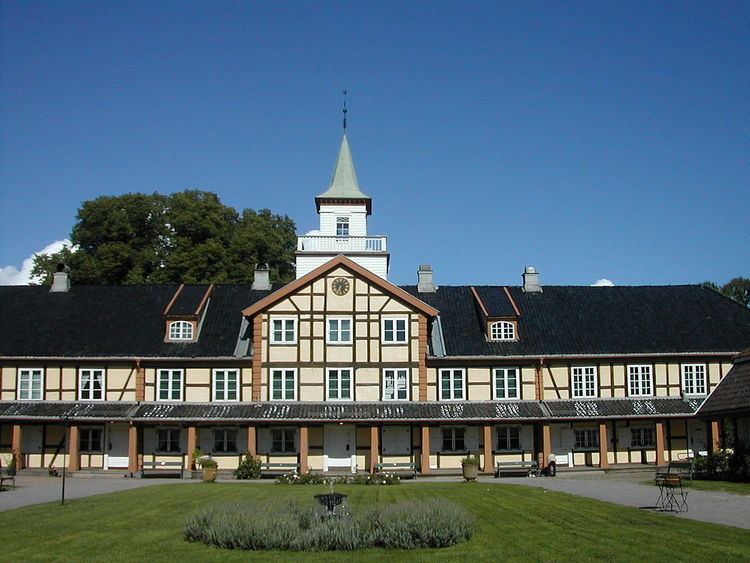Established 1 January 2006 | Director Lars Emil Hansen | |
 | ||
Location Frogner Park and Grønland | ||
Oslo Museum (Norwegian: Oslo museum) is a museum in Oslo dedicated to the history and culture of Oslo. It was formed in 2006 by the merger of Oslo City Museum, the Intercultural Museum and the Theatre Museum, which are now departments within Oslo Museum. A fourth museum, the Labour Museum, joined in 2013. The museum is headquartered at Frogner Manor in Frogner Park, together with two of its departments, the City Museum and the Theatre Museum.
Contents
History
City Museum, Intercultural Museum, and Theatre Museum joined forces to create the new museum as a consequence of the State Museum reform. The new museum foundation functioned under the working title "Capital Museum", but from December 2006, it adopted the name "Oslo Museum".
Departments at Oslo Museum
The museum consists of the following departments: Bymuseet, Theatre Museum, Intercultural Museum and Work Museum. City Museum and Theatre Museum are located at Frogner Manor in the outskirts of Frogner Park. Intercultural Museum is located in Grønland, address Tøyenbekken 5, while the Labour Museum is housed in Sagveien 28 on Sagene.
City Museum
The City Museum, formerly Oslo City Museum, is the cultural history museum of Oslo City located in the former Aker Parish. The museum was founded 22 December 1905 by the "Old Christiania" Association. The leader was architect Fritz Holland until 1912. The museum is located at Frogner Manor in Frogner Park, where the first exhibition was opened in the main building in 1909.
Intercultural Museum
The Intercultural Museum, formerly the International Cultural Center and Museum, is located in Grønland Culture Station, Tøyenbekken 5 in Oslo. The museum was started in 1990 by Bente Guro Møller and works to promote understanding and respect for cultural diversity. On the ground floor the museum has a permanent exhibition focusing on immigration history and cultural changes in Norwegian society. The gallery exhibits topical art from artists with immigrant backgrounds. In addition, the museum organizes seminars, concerts, lectures and discussion evenings. In 1999 the museum moved to Grønland Culture Station and the old prison cells were converted into a museum. The house includes an art gallery, concert hall, seminar rooms, and a culture workshop.
Theatre Museum
The Theatre Museum is a museum of theatre and history of theatre. The museum was established in 1972, but the precursor Christiania Theatre Historical Society opened in 1939 a theatrical exhibition in Rådmann farm, Rådhusgata 19. The museum is currently co-located with the City Museum in Frogner Park.
Founding members of the Christiania Theatre Historical Society in 1922 was actor/theater director/artist Johan Fahlstrøm (1867-1938), actress Sophie Reimers (1853-1932), actor Harald Otto (1865-1928) and director/theatre historian Johan Peter Bull (1883-1960). Bull was the Society's first chairman and the driving force behind the collection of artifacts. The objects were in 1947 transferred to Norwegian Actors' Equity Association. In 1956 the Theatre History company created a successor of the Theatre History Association. The purpose was to support the museum and promote theatre research. The museum was formerly organized as a foundation in 1972 with Trine Naess as managers.
The Theatre Museum did not permanently reside in Rådhusgata 19, but acquired new premises in the Old Town Hall, Lower Castle Gate 1 from 1981, the same year under the support schemes for semi-public museums with grants from Oslo county. Meanwhile, the museum had a temporary exhibitions in Oslo's information center in 1975, "Teatermuseet i seneste laget".
After a fire on 5 May 1996, Teatermuseet was closed but regained a new location in Rådhusgata 19 in 1997. Trine Naess left in spring 2000, and was replaced by Ragnhild Wang from 2000 to 2006. By the end of 2010 Oslo Museum discontinued their tenancy in the Old Town Hall for economic reasons.
In 2008 a new theatre historical exhibition opened in the City Museum east wing, entitled "I rampelyset – scenekunst i Oslo frem til i dag". The exhibition examines the main features and highlights of Oslo's theater and performing arts history, ranging from the early theaters, opera and ballet, to the exuberant Variety Halls.
Labour Museum
The Labour Museum opened in Apotekergarden, Sagveien 28 on Sagene in June 2013. The museum shows the industrial and human history of the areas along the Aker River, which was important in the development of Norwegian industry from the 1840s.
Collections
Oslo Museum collects all types of cultural material that can illuminate the historical and contemporary Oslo. The objects are stored in reservoirs at the Museum at Frogner, and in some satellites around Oslo. Many of these are digitized and made available to the public on DigitalMuseum. Particularly valuable are the art collection and photo collection with Oslo scenes and portraits. The photo collection is one of the largest and documents the city's development from photography's infancy to the present. In 2010 Oslo Museum along with the Oslo City Archives established the site oslobilder.no with searchable access to the digitized parts of photo collections from both institutions.
Dissemination
Oslo Museum displays the museum's exhibitions and also has satellite exhibitions in working homes on Toyen and Sagene. The museum manages events and city tours in the "Know Your CIty" program and publishes the journal Byminner. The museum has at any given time several traveling exhibitions on tour in the country.
Labour Museum
In 2011 Oslo Museum received 2.5 million kroner from the Ministry of Culture for a new labour museum to convey industrial culture. Oslo Museum will cooperate with the Norwegian Museum, borough Sagene and the Labour Movement Archives and Library and create an outdoor museum and a small interpretive center. The planned opening of a visitor center was 2013.
